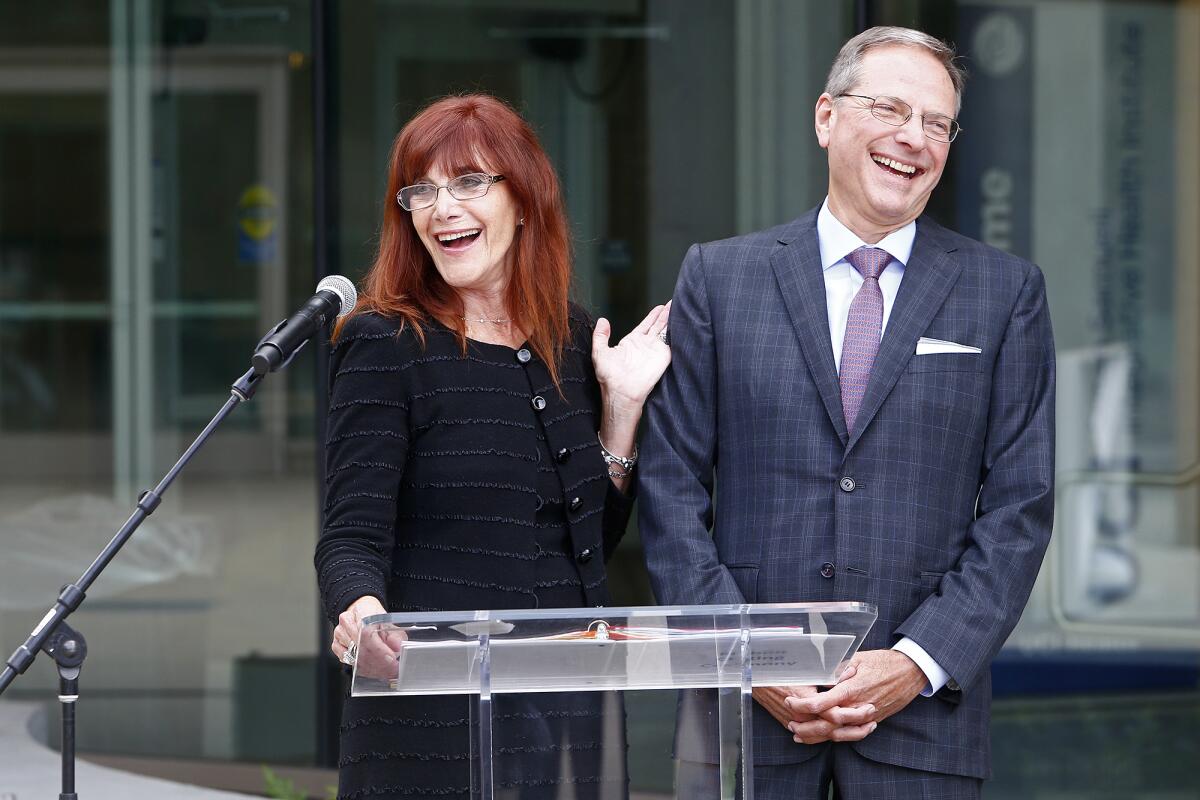Samueli Foundation commits $15 million to new O.C. nonprofit initiatives following needs report

- Share via
Lindsey Spindle is entering her fourth year as president of the Samueli Family Philanthropies, but she drew on her early experience working on Capitol Hill at a Tuesday event highlighting the release of the Orange County Nonprofit Needs Assessment Report.
She remembered attending a meeting when a congressional appropriations committee was discussing healthcare funding. Hospitals, insurers and physicians all had lobbyists there. Patients weren’t in the room.
For the record:
7:30 a.m. March 22, 2025This story has been updated to accurately reflect Lindsey Spindle’s title.
“Outside of this testimony, this hearing, there was a group of cancer patients holding signs saying, ‘Nothing about me without me,’” Spindle told the group of philanthropists and nonprofit leaders gathered at UC Irvine. “That is why we did this report the way we did it. It has to be about you as told by you, instead of people looking outside in.”
In partnership with Charitable Ventures and UCI, the Samueli Foundation and Orange County Community Foundation surveyed more than 600 county nonprofit leaders from about 400 organizations to issue the needs assessment report, which revealed obstacles that nonprofits typically encounter in their field. Thirteen focus groups and a town hall meeting also provided insight.

The main challenges uncovered included investing in staff and leadership, infrastructure and financial sustainability, collaboration and restrictive funding models.
Spindle said Tuesday that the Samueli Foundation, headquartered in Corona del Mar, is committing $15 million toward three new initiatives in leadership development, capital funding and hard-to-fund needs.
She said she’s most excited about the Breakaway Fund, a nod to Henry and Susan Samuelis’ status as owners of the Anaheim Ducks hockey team. It’s an annual $5-million grant-making initiative designed to remove financial barriers for nonprofits seeking to invest in things like upgrading infrastructure and technology, strengthening leadership capacity and retaining key staff.
“This is to fund the stuff that no one else will fund,” Spindle said. “Stuff to support your people. Money to buy stuff like laptops or printers, training, outside expertise. A lot of people tell us, ‘We need legal help, but we can’t pay for it, so we rely on volunteer board members’ … People told us what they don’t have access to, and we’re trying to answer it with this fund.”
The Build OC capital funding project and the Breakaway Fund will launch on May 1 on the Samueli Foundation website. As for the Leading for Impact and Leadership Accelerator programs, a $5-million, five-year leadership development investment run by the Bridgespan Group, the first cohort of LFI participants is already registered for work beginning in September.

The report itself had some alarming numbers to Spindle and other nonprofit leaders. At Tuesday’s event, she participated in a round-table discussion with Orange County Community Foundation chief executive Shelley Hoss and Anne Olin, the president and chief executive of Charitable Ventures.
Remarks from nonprofit leaders were played on a video screen as each topic was discussed.
Nonprofits are often cash-strapped. Per the report, nearly one in five, or 19% of those surveyed countywide said their nonprofit had no financial reserves, while 56% said they did not have access to credit or loans for financial stability.
“The fact that we are under-capitalized was not a shock,” said Hoss, who has nearly four decades in the nonprofit space. “The fact that one in five said they have no capital reserve, that’s a big problem. That number surprised me.”
And when funds can be accessed, it’s often short-lived, as 82% of respondents said that gaining access to multi-year funding was either very difficult or moderately difficult.
Staffing is also a concern, with 71% of respondents saying their employees always or often take on multiple responsibilities.
“Staffing is not overhead,” Hoss told the crowd assembled. “In fact, the mythology that you can somehow separate the program delivery from the people who are delivering the programs is like the definition of insanity. That is just not the reality that our nonprofit sector operates in.”

Hoss said the Samueli family has always been generous, but she’s excited about the new initiatives.
“What I love about this new direction is how strategic and focused the effort is on the early learnings from the study, really looking to remove the most limiting barriers,” she said. “It’s really being laser focused, and we know that’s just going to be the beginning.”
Spindle said a key is to look at nonprofit organizations as businesses, rather than charity.
“Orange County is a very affluent place and we have a dangerously fragile nonprofit sector,” she said. “There’s a mismatch there.”




